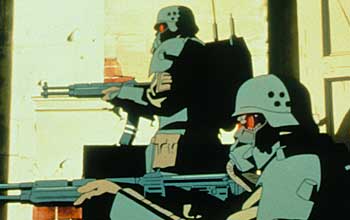
by Luis Reyes
|
Given the connection to real events in Japan's recent past, how is the film received in Japan? Did Japanese audiences make the connection to the occupation? Did it trigger any emotions connected with what's going on in Japan now? Oshii: I'm not really sure because most of the audiences that went to go see "Jin-Roh" in Japan where mostly
young � or not as old as me. They haven't really experienced any of the past that I remember. There is still a large
amount of young people in Japan that don't know we fought with the United States. They don't even know what direction
Japan was headed afterwards. They're a lot of people in Japan that don't know anything about what happened.
Do you feel that "Jin-Roh" has missed its true audience? Oshii: I already had the potential audience in mind when I wrote the movie, so it, in some ways, is a
means by which to educate Japan's youth.
Based on your experience with "Ghost in The Shell" and the popularity that movie enjoys here in America, what kind of elements do you think will resonate most with an American audience? Oshii: I feel there are two things in general for all audiences. One is how the audience interprets
the history of Japan and the impact of that story on an audience that isn't aware of the past. The other one is more
of a personal story, between a human and the beast within. So whatever audience sees this movie, it should have a good
reaction.
Because essentially the story itself, as you've stated before, is a universal story about a man's struggle with himself. Oshii: Right.
You said that you wanted to educate younger people about their past through this film, but you also said that you deliberately wanted to make sure this film was set in an imaginary world. If you're trying to tell the younger generation something about their history, but not through their reality, then you get to choose. So which one is it? Oshii: I don't want to tell the audience the actual facts, but I want them to understand these kinds of
people existed and these kinds of conflicts were around.
What conflicts in "Jin-Roh" do you see still existing in Japan's society? What does this film reflect about modern day Japan? Oshii: I'm very unhappy with the way people behave in modern Japan. People like Fuse do not exist anymore
today. In the past there were a lot of people like that, that still had the spirit of the wolf in them. I myself was
once like that too. Now there's no one around like that.
Who replaced that person in Japan? Oshii: Sheep.
So the audiences that go to see "Jin-Roh" are just a bunch of sheep watching the wolf? Oshii: Perhaps there are still people like that around but it's all hidden. They aren't howling out. In the
future I hope the wolf-like people will be howling out, doing something proactive rather than watching all the time.
The interview ended, the pen sheathed, and the tape recorder stopped, and Viz Communications and Bandai Entertainment publicity representatives shuttled Oshii out of the room to another interview. But as I packed to leave, eager to nestle into a good seat for the mid-afternoon press screening of "Jin-Roh," Viz producer Toshifumi Yoshida approached me with a point that Mr. Oshii had made but, in the mad pace of Oshii's interview schedule, his translator had abridged. "The Japanese wolf is extinct now," Yoshida explains. "Back in the 60s they existed but they are not around anymore. So, physically, there is no Japanese wolf. Just like the kind of person represented by Kazuki Fuse, it went with the times." Physically, philosophically and psychologically the Japanese wolf is a thing of the past, the very past that Oshii attempts to elucidate for a contemporary audience in which the wolf spirit lies dormant. |
|||||
|
Jin-Roh: The Wolf Brigade © Mamoru Oshii / Bandai Visual / Production I.G / Bandai Ent. / Viz Films.
|


